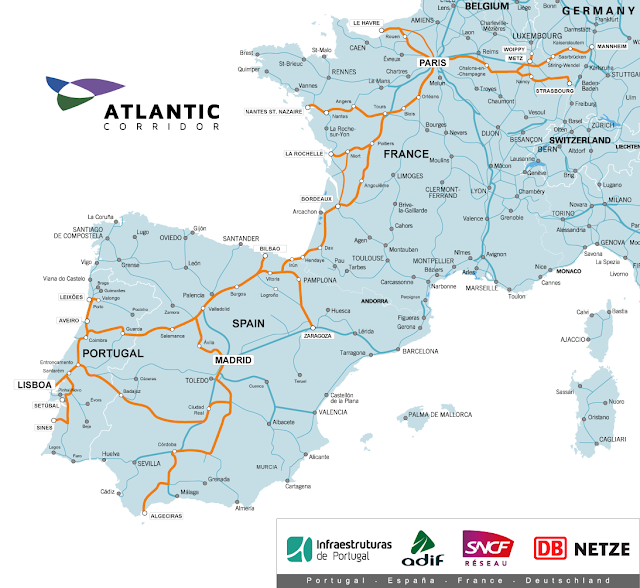Rail transport in Europe : one interlocutor from Mannheim to Lisbon
By Mediarail.be - Signalling technician and railways observer
See also the Trainworld on facebook of Mediarail.be, also Twitter and LinkedIn
04/02/2016
Since the beginning of the year 2016, the European rail freight corridor "Atlantic" is extended from the French border by a German section toward Saarbrücken and Mannheim. The legal basis for this was the accession of the DB Netz AG to the European Economic Interest Grouping (EEIG) of this rail freight corridor. This advantage allows railway undertakings and authorized applicants in cross-border rail freight to benefit of the DB network thanks to this extension. This corridor is one of the nine described on the basis of EU Regulation (EU) no. 913/2010 concerning freight corridors . The aim is to increase the competitiveness and quality of international rail freight.
Which advantage ?
The interest of a European freight corridor is to find a single correspondent in a One Stop Shop for several countries crossed, whereas before, it was necessary to address by each national entity, with a lot of administrative difficulties. The interest of a corridor is also to establish complete train paths from one end to the other, with a minimum of waiting time at borders and a maximum of coordination. There is therefore a real office in which one team handles the entire corridor. The Atlantic Corridor has established a representative One-Stop Shop, in which ADIF acts on behalf of the four infrastructure managers. The Corridor One-Stop Shop (or C-OSS) is placed in Madrid and is supported by the coordinating IT-tool PCS (Path Coordination System). Subsequently, the Atlantic Corridor also works as a coordination platform between Portugal, Spain, France and Germany concerning the investments in infrastructure, overcoming technical and operational barriers, promoting interoperability and, ultimately, increasing the competitiveness of rail freight.
« With the extension of the freight corridor "Atlantic" we are pleased to now be able to offer attractive offers for traffic to and from West Europe, », says Oliver Sellnick, for European Corridor Management at DB Netz AG. « By the fourth corridor on our network, we take the lead among infrastructure managers in Europe to build a rail network for a competitive freight. The growing market for international transport corridors provide an excellent way to realize efficient freight transport by rail. »
The Atlantic Corridor is part of the homonym multimodal corridor integrated in the TEN-T Core network and connects with the Mediterranean Corridor in Madrid and Zaragoza, with the North Sea-Mediterranean Corridor through Paris, Metz and Strasbourg. Furthermore, the recent extension of the Atlantic Corridor to Mannheim in Germany enabled a direct articulation with two other corridors: the Rhine-Alpine and the future Rhine-Danube, thus increasing outreach of the Atlantic Corridor. This corridor, formerly named Rail Freight Corridor No. 4, includes the existing railway lines and planned itineraries between Sines / Setúbal / Lisbon / Aveiro / Leixões - Algeciras / Madrid / Bilbao / Zaragoza – Bordeaux / La Rochelle / Nantes / Paris / Le Havre / Strasbourg – Mannheim, crossing the international borders of Vilar Formoso/Fuentes de Oñoro, Elvas/Badajoz, Irun/Hendaye and Forbach/Saarbrücken.
 |
- Tracks with European gauge in France and Germany (1435 mm) and Iberian gauge in Spain and Portugal (1668 mm);
- Itineraries with double track from France to Mannheim and Strasbourg Port du Rhin, between Le Havre, Metz, Paris and the south of Madrid (Santa Cruz de Mudela), and also between Lisbon and Porto;
- Itineraries with single track between the south of Madrid (Santa Cruz de Mudela) and Algeciras and in the two branches connecting Spain to Portugal (Medina del Campo-Pampilhosa and Manzanares-Entroncamento), in two sections of the connection from Poitiers to La Rochelle Port in France and from Alsasua to Castejón de Ebro in the Spanish connection to Zaragoza;
- Different electrified itineraries : 15kV AC in Germany, 25kV AC in North-East of France to Paris, 1500V DC from Paris to Irun by Bordeaux, 3kV DC in Spain and 25kV AC in Portugal ;
- Partially electrified itineraries (25kV AC) on the two branches connecting Spain to Portugal (Medina del Campo-Pampilosa and Manzanares-Entroncamento);
- Non electrified itinerary between the south of Cordoba (Antequera) and the port of Algeciras;
- Several different signalization systems between Germany, France, Spain and Portugal;
- Very variable maximum gross load charge according to geographical areas connected to the topography of the existing network, with a load of 22,5 ton by axle on the totality of the route.
One of the goals of the Atlantic Corridor is to harmonize the technical characteristics of the infrastructures and to coordinate investment to overcome the existing diversities. It is however not possible or optimal that a single locomotive covers the whole Atlantic corridor routes. There will always be a change of locomotive at the border with Spain due to the different gauge of the tracks between the two countries. However, a German locomotive is likely to ride up to Irun, but the experience has shown that operators do not like to see their locomotives too far of their base, for the repair service of the locomotives or the breakdown of the drivers.
This example, however, shows the need of European action for promote the quality of railways. Some technical points are supported in part by European funds.
 |
| (photo http://www.atlantic-corridor.eu/) |